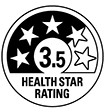Reading a food label can be overwhelming. Food labels are meant to help us make an informed decision about the food that we are buying, but they can also be a huge source of confusion if you don’t know what to look for or where to start.
To help you make healthier choices, I suggest using these two simple tips when choosing between similar products:
1. Make sure you look at the ingredient list. Ingredients are listed in descending order by weight, with the main ingredients listed first. Check to see if there are any ingredients containing saturated fat, added sugar or sodium (salt). Look carefully as there are different names that these ingredients could be listed as.
2. On the Nutrition Information Panel, use the per serve column if you want to know how much you are consuming in that serve and use the per 100g column when comparing similar food products. If you are a healthy person you should be aiming for less saturated fat, added sugar, sodium (salt) and energy (kilojoules), but making sure you are getting plenty of fibre.
What else to look out for:
High saturated fat
This type of fat can increase your blood cholesterol. Aim for less than 3g per 100g and choose the food product that has the lowest amount per 100g.
Added sugar
Choose food products that have the lowest amount of added sugar. To find out if a product has added sugar, check out the ingredients list. Spotting sugar isn’t as easy as it once was. Be on the lookout for other names for added sugar that can masquerade as healthier alternatives including maple syrup, honey, and barley malt syrup. Also, be on the lookout for ingredients that end in “ose”. Aim for less than 15g per 100g and choose the food product that has the lowest amount per 100g.
Too much sodium (salt)
When you read the Nutrition Information Panel (NIP), it’s important to remember that the salt content of the food product will be listed as ‘sodium’. To compare the sodium content of two similar products, you should read the “Per 100g” column of the NIP. Aim for less than 400mg per 100g, or even better less than 120mg per 100g and choose the food product that has the lowest amount per 100g. If you are short on time, look for foods labelled ‘low salt’ ‘salt reduced’ or ‘no added salt. Don’t forget to also check the ingredient list for other names for salt, such as monosodium glutamate, and vegetable salt. If you are interested in learning more about sodium, read the blog post for Salt Awareness Week.
High energy (kilojoules or calories)
Excess energy in the diet can lead to weight gain. Understanding which products are energy-dense can help you balance the energy you consume with the energy your body burns. Avoid discretionary foods as they are usually high in energy and provide little nutrients. One serve of discretionary food provides approximately 600kJ. If it’s a choice between a chocolate bar or a piece of fruit, the fresh produce is undoubtedly the better option.
Don’t forget fibre
Many Australians do not consume the recommended 30g/day for men and 25g/day for women. Aim for more than 3g per serve and choose the food product that has the highest amount per 100g.
Can we trust the nutrition and health claims on packaged foods?
You may also see nutrition content claims and health claims listed on a food label.
Nutrition content claims
These may be listed on food products depending on its nutrient content, such as good source of calcium or low in fat.
Health claims
These refer to the relationship between food products and health. There are general level health claims, such as calcium for healthy bones and teeth and high level health claims, such as diets high in calcium may reduce the risk of osteoporosis in people 65 years and over.
Both nutrition and health claims in Australia need to meet strict criteria set out by the Australia New Zealand Food Standards Code. In turn, any claims on packaged items can be trusted. It is important however to not use these claims alone to make healthy choices.
Health Star Rating
The Health Star Rating may also appear on food labels in Australia. Using the Health Star Rating Calculator, food products are assigned a rating from ½ to 5 stars. The higher the number of stars, the “healthier” the food product. This rating can be displayed in two different ways, the first just shows the rating and the second also includes information from the Nutrition Information Panel.


You should only use this rating to compare similar food products and the Health Star Rating is voluntary, so not all food labels have it. There are also loopholes to the system where products such as Milo® has a 4.5 star rating, based on the recommended serving of three teaspoons made with skim milk whereas on its own it would have a far lower star rating. Following controversy, Nestlé has since chosen to remove the Health Star Rating from the packaging of Milo® powder in Australia.
So next time you're at the supermarket, use the tips listed in this blog post to help you choose healthier food products.
Want to learn more? Check out this helpful guide.
 Author: Danielle Cave
Author: Danielle Cave
PhD student and Accredited Practising Dietitian



